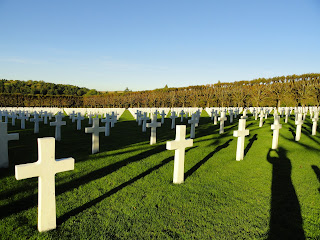There is much to explore about the campaign in the area and the country itself looks similar to what it did in 1918 before the carnage of the fighting; largely rural farmland and dotted with patches of woods, small towns, and tiny villages. Those who study the campaign say that there are a number of monuments and markers scattered about. Some of them have disappeared over the years, destroyed by French farmers who found them to be a nuisance for their planting or simply lost to the weeds and woods. Many other sites of significant American actions and heroism remain unmarked and waiting on the curious to find. With a good map, one can see where individuals like Alvin York, Harry Truman, George Patton, and Douglas MacArthur fought their individual actions, or where Charles Whittlesey and his "Lost Battalion" of the 77th Division gained fame. You might also find where other, lesser known soldiers carried individual acts of heroism, like Private Lewis "Jack" Barkley of the 3rd Division, who fought off an entire German 600-man battalion and won the Medal of Honor for his deed. Similarly, you might walk little-known places where American units fought some of the bloodiest actions in US military history, like Cote Dame Marie, Hill 258, Hill 253, Bois des Ogons, Bois de Fays, and the Madeleine Farm. Again, it was unfortunate we could give the area only a cursory visit. Though we drove up the main axis of the American advance, we stopped at just two sites, the American monument at Montfaucon and the cemetery at Romagne. To see where we went and the ground of the American offensive, check out this website: http://www.usaww1.com/American-Expeditionary-Force/American-Expeditionary-Force-Meuse-Argonne.php4
For anyone interested in the details of the campaign, I recommend Edward Lengel's To Conquer Hell: The Meuse-Argonne, 1918. Although a bit repetitious, it is well written, superbly researched, and probably the most comprehensive account of the campaign to date. I doubt the book will be surpassed. For an overall look at the American experience in WW1, try John S. D. Eisenhower's Yanks: The Epic Story of the American Army in World War 1 or The AEF Way of War by Mark E. Grotelueschen. To read about the experience at the small unit and soldier (or marine) level, try The Remains of Company D by James Carl Nelson or James Boyd's 1923 novel Through the Wheat, which F. Scott Fitzgerald called "...not only the best combatant story of the Great War, but also the best war book since The Red Badge of Courage." Jack Barkley's memoir is (Scarlet Fields) coming out soon as well.
Now on to the tour. Off to the northwest of Verdun and generally out in the middle of nowhere stands the Montfaucon American Monument, which pays tribute to all the American forces that fought in the Meuse-Argo
The monument. On the wall below the column are tributes to all the American infantry divisions that took part in the offensive.
Behind the monument are the ruins of the village of Montfaucon
Notice the bunker/obs
Another bunker on the Montfaucon hillside.
From Montfaucon, we continued along the axis of the American advance to the Meuse-Argo
It was a lovely, peaceful, and sobering place we visited on that quiet fall afternoon. There were no other souls about and the only sounds were the leaves rustling along the ground and our whispered comments while we walked among the many rows of white crosses and the occasional Star of David.
Last, as we were leaving the Meuse-Argonne area, we stopped off to check out a monument in the middle of a small town called Dun-on-the-Meuse. The monument spoke for itself. The 5th Division liberated the town in November of 1918 shortly before the Armistice. On the left hand side of the monument is the obligatory tribute to the villagers who died serving in the "Great War." This was one of many such monuments we saw during our trip through the provinces of eastern France. Just like many small American towns have their monument to Johnny Reb or Billy Yank, each French village seemed to have its tribute to the "Poulis" or "hairy one," the warmly informal name for the WW1 French infantryma





























No comments:
Post a Comment